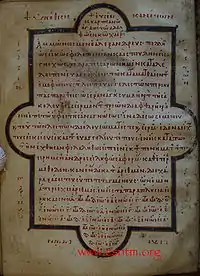| New Testament manuscript | |
 Hypothesis kanonon | |
| Text | Gospels |
|---|---|
| Date | 11th century |
| Script | Greek |
| Now at | Orlando, Florida |
| Size | 15.4 cm by 12.3 cm |
| Type | ? |
| Category | none |
| Hand | large |
Minuscule 682 (in the Gregory-Aland numbering), ε 157 (von Soden),[1][2] is a Greek minuscule manuscript of the New Testament, on parchment. Palaeographically it has been assigned to the 11th century. The manuscript has complex contents.[3][4] Scrivener labelled it by 533e.[5]
Description
The codex contains the text of the four Gospels, on 309 parchment leaves (size 15.4 cm by 12.3 cm).[3][1] The text is written in one column per page, 18 lines per page.[3][6] The first page being in gold.
The text is divided according to the κεφαλαια (chapters), whose numbers are given at the left margin, and their τιτλοι (titles) at the top. The tables of the κεφαλαια are placed before each Gospel. There is also a division according to the smaller Ammonian Sections (in Mark 233), a references to the Eusebian Canons.[6]
It contains Epistula ad Carpianum, the Eusebian Canon tables, several Prolegomena to the four Gospels, Prolegomena, and subscriptions at the end.[5][6]
It has unusual marginal note on folio 28 recto.[7]
According to the CSNTM description it has 308 pages.[7]
Text
Kurt Aland did not place it in any Category.[8]
The manuscript was not examined by using the Claremont Profile Method.[9]
History
Scrivener and Gregory dated the manuscript to the 11th century.[6] Currently the manuscript is dated by the INTF to the 11th century.[4]
It was added to the list of New Testament manuscript by Scrivener (533) and Gregory (682). It was examined by Guildford.[5]
The manuscript was acquired along with seven other manuscripts (556, 676, 677, 678, 679, 680, and 681) by the late Sir Thomas Phillips, at Middle Hill in Worcestershire.[5] The manuscript was held in London (Cheltenham 7757).[6] In the twenties of the twentieth century it was transferred to United States.
Actually the manuscript is housed at the Scriptorium (VK 905), Orlando, Florida.[3][4]
Gallery
 The first page of Matthew
The first page of Matthew The first page of Mark
The first page of Mark
See also
References
- 1 2 Hermann von Soden, Die Schriften des neuen Testaments, in ihrer ältesten erreichbaren Textgestalt / hergestellt auf Grund ihrer Textgeschichte (Berlin 1902), vol. 1, p. 143.
- ↑ Gregory, Caspar René (1908). Die griechischen Handschriften des Neuen Testament. Leipzig: J. C. Hinrichs'sche Buchhandlung. p. 72.
- 1 2 3 4 Aland, K.; M. Welte; B. Köster; K. Junack (1994). Kurzgefasste Liste der griechischen Handschriften des Neues Testaments. Berlin, New York: Walter de Gruyter. p. 87. ISBN 3-11-011986-2.
- 1 2 3 Handschriftenliste at the Münster Institute
- 1 2 3 4 Scrivener, Frederick Henry Ambrose; Edward Miller (1894). A Plain Introduction to the Criticism of the New Testament, vol. 1 (fourth ed.). London: George Bell & Sons. p. 251.
- 1 2 3 4 5 Gregory, Caspar René (1900). Textkritik des Neuen Testaments, Vol. 1. Leipzig. p. 212.
{{cite book}}: CS1 maint: location missing publisher (link) - 1 2 CSNTM description
- ↑ Aland, Kurt; Aland, Barbara (1995). The Text of the New Testament: An Introduction to the Critical Editions and to the Theory and Practice of Modern Textual Criticism. Erroll F. Rhodes (trans.). Grand Rapids: William B. Eerdmans Publishing Company. pp. 133, 139. ISBN 978-0-8028-4098-1.
- ↑ Wisse, Frederik (1982). The Profile Method for the Classification and Evaluation of Manuscript Evidence, as Applied to the Continuous Greek Text of the Gospel of Luke. Grand Rapids: William B. Eerdmans Publishing Company. p. 64. ISBN 0-8028-1918-4.
Further reading
- Gregory, Caspar René (1900). Textkritik des Neuen Testaments. Vol. 1. Leipzig: J.C. Hinrichs. p. 212.
External links
- Images of Minuscule 682 at the CSNTM